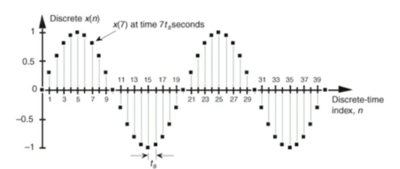Signal Processing
Signal Processing is the manipulation and analysis of both analog and digital (sampled and quantized) signals. For example, a common use of both analog and digital processing is for filtering electrical signals to remove unwanted noise or to separate one signal from another. Examples of more sophisticated uses of signal processing arise in the formation of an X-ray CT image for medical diagnosis, or in machine recognition and synthesis of speech. Increasingly sophisticated uses of signal processing have appeared in these areas and in many others, including communications, control, image and video processing, radar, sonar, geophysical exploration, and consumer electronics. This expanded use of signal processing techniques has been prompted by advances in both the mathematical theory and the physical devices used for signal processing. This is especially true for digital signal processing, where sampled and quantized analog signals are processed using computers or special-purpose digital hardware.[1]
Categories of Signal Processing[2]
- Analog: Analog signal processing is for signals that have not been digitized, as in most 20th-century radio, telephone, radar, and television systems. This involves linear electronic circuits as well as nonlinear ones. The former are, for instance, passive filters, active filters, additive mixers, integrators, and delay lines. Nonlinear circuits include compandors, multipliers (frequency mixers, voltage-controlled amplifiers), voltage-controlled filters, voltage-controlled oscillators, and phase-locked loops.
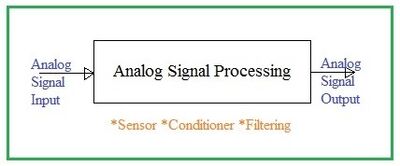
source: RF Wireless World
- Continuous time: Continuous-time signal processing is for signals that vary with the change of continuous domain (without considering some individual interrupted points). The methods of signal processing include time domain, frequency domain, and complex frequency domain. This technology mainly discusses the modeling of linear time-invariant continuous system, integral of the system's zero-state response, setting up system function and the continuous time filtering of deterministic signals
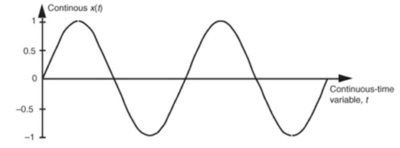
source: Maël Fabien
- Discrete time: Discrete-time signal processing is for sampled signals, defined only at discrete points in time, and as such are quantized in time, but not in magnitude. Analog discrete-time signal processing is a technology based on electronic devices such as sample and hold circuits, analog time-division multiplexers, analog delay lines and analog feedback shift registers. This technology was a predecessor of digital signal processing (see below), and is still used in advanced processing of gigahertz signals. The concept of discrete-time signal processing also refers to a theoretical discipline that establishes a mathematical basis for digital signal processing, without taking quantization error into consideration.
- Digital: Digital signal processing is the processing of digitized discrete-time sampled signals. Processing is done by general-purpose computers or by digital circuits such as ASICs, field-programmable gate arrays or specialized digital signal processors (DSP chips). Typical arithmetical operations include fixed-point and floating-point, real-valued and complex-valued, multiplication and addition. Other typical operations supported by the hardware are circular buffers and lookup tables. Examples of algorithms are the fast Fourier transform (FFT), finite impulse response (FIR) filter, Infinite impulse response (IIR) filter, and adaptive filters such as the Wiener and Kalman filters.
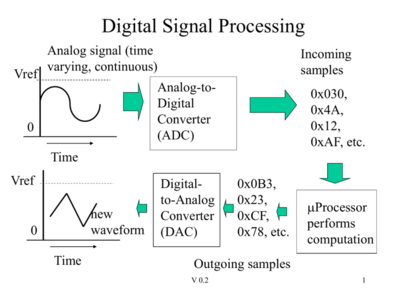
source: IEEE
- Nonlinear: Nonlinear signal processing involves the analysis and processing of signals produced from nonlinear systems and can be in the time, frequency, or spatio-temporal domains. Nonlinear systems can produce highly complex behaviors including bifurcations, chaos, harmonics, and subharmonics which cannot be produced or analyzed using linear methods. Polynomial signal processing is a type of non-linear signal processing, where polynomial systems may be interpreted as conceptually straight forward extensions of linear systems to the non-linear case.
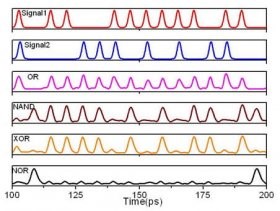
source: Optcomm
- Statistical: Statistical signal processing is an approach which treats signals as stochastic processes, utilizing their statistical properties to perform signal processing tasks. Statistical techniques are widely used in signal processing applications. For example, one can model the probability distribution of noise incurred when photographing an image, and construct techniques based on this model to reduce the noise in the resulting image.

source: SPL
Signal Processing in Biometrics[3]
There are various reasons for processing signals. The biometric systems, require voice processing for various reasons −
- To extract meaningful information from the candidate’s sample.
- To remove noise from the sample.
- To make the sample transmittable.
- To remove distortion of sample.
The analog signal processing module converts real world information such as sound wave in the form of 0s and 1s to make it understandable and usable by the contemporary digital systems such as biometric systems. The keystrokes, hand geometry, signature, and speech fall into the domains of signal processing and pattern recognition.
Importance of Signal Processing[4]
Signal processing – the enabling technology for the generation, transformation, extraction and interpretation of information via electronic signals – is essential for our smartphones and wearable devices, as well as the latest health care technologies, digital cameras and our digital assistants like Amazon Echo and Google Home. Taking stock of the immense power and promise of signal processing, it’s not difficult to see why it is so important:
- Signal Processing Plays a Key Role in Multiple Industries: Signals are used to transmit information in nearly every imaginable field. They are used extensively in what will likely be a high-growth industry in years to come: health care. Signal processing is essential for the use of X-rays, MRIs and CT scans, allowing medical images to be analyzed and deciphered by complex data processing techniques. Signals are used in finance, to send messages about and interpret financial data. This aids decision-making in trading and building stock portfolios. The most exhilarating new movies are made possible by multiresolution signal processing in digital cameras, making entertainment a lucrative market for people with this skillset. And of course, there is the ever-dynamic consumer electronics industry, where smartphones, wearable devices and digital home assistants couldn’t exist without processing engineers. Basically, whatever industry one can think of probably implements signal processing.
- Signal Processing is the Technology of the Future: Signal processing is the technology underpinning most of our disruptive innovations. Just to give a few examples, the latest breakthroughs in health care are enabled by signal processing engineers, who are developing ways to more quickly and accurately process medical images. Signal Processing is being used by Hollywood to make the most memorable and exciting films. And in Silicon Valley, where disruption is the order of the day, the top tech companies are using signal processing to help develop the latest product or platform. These are the growth industries of the modern economy – and signal processing is contributing to this growth.
- Signal Processing Can Serve a Social Purpose: Whether addressing inequality, making our economy more sustainable or combatting epidemics, it’s key that researchers and policymakers have access to all the relevant data. Signal processing allows for the expansion of computing power and data storage capabilities, making signal processing engineers indispensable for understanding and tackling our biggest global problems.
See Also
References
- ↑ Definition - What Does Signal Processing Mean? UI Urbana-Champagne
- ↑ Categories of Signal Processing Wikipedia
- ↑ Signal Processing in Biometrics Tutorial Point
- ↑ Why is Signal Processing Important? SPS

